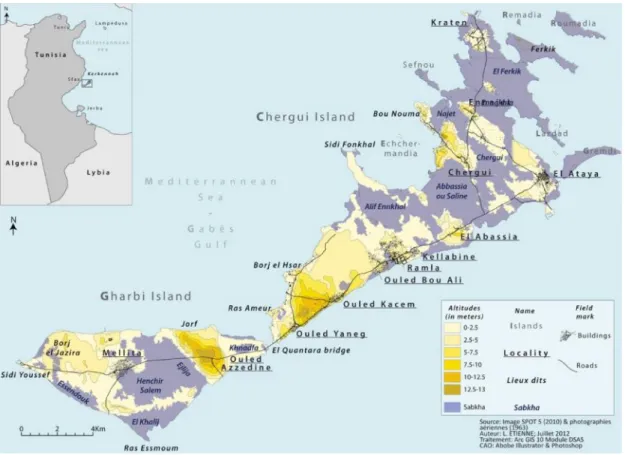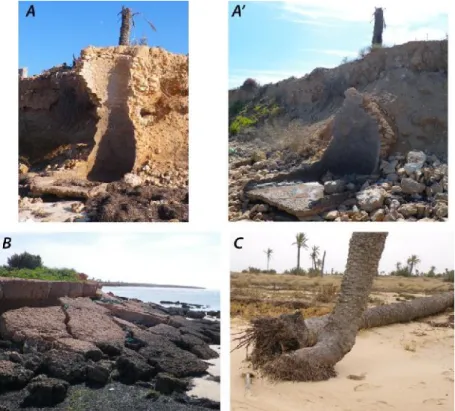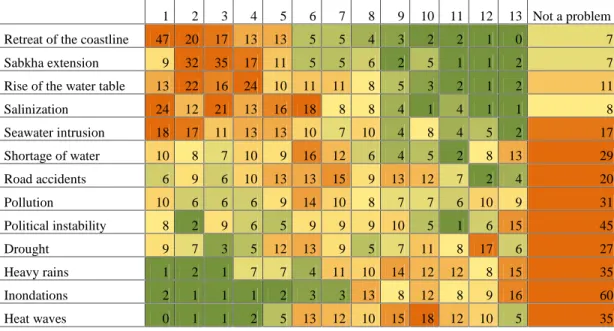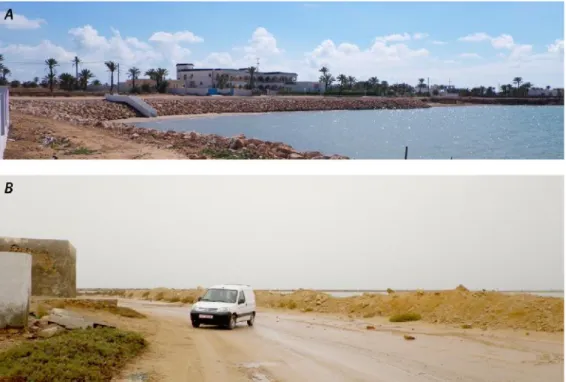HAL Id: hal-01108667
https://hal.archives-ouvertes.fr/hal-01108667
Submitted on 23 Jan 2015HAL is a multi-disciplinary open access archive for the deposit and dissemination of sci-entific research documents, whether they are pub-lished or not. The documents may come from teaching and research institutions in France or abroad, or from public or private research centers.
L’archive ouverte pluridisciplinaire HAL, est destinée au dépôt et à la diffusion de documents scientifiques de niveau recherche, publiés ou non, émanant des établissements d’enseignement et de recherche français ou étrangers, des laboratoires publics ou privés.
Lucile Etienne, Gérard Beltrando, Abdelkarim Daoud
To cite this version:
Lucile Etienne, Gérard Beltrando, Abdelkarim Daoud. Human Influences on Environmental Changes in The Kerkennah Archipelago (Tunisia) Since The 60’s. 3rd international geography symposium, 2013, Antalya, Turkey. �hal-01108667�
Human Influences on Environmental Changes
in The Kerkennah Archipelago (Tunisia) Since The 60’s
L. ETIENNE - G. BELTRANDO - A. DAOUD
(LE – GB) Université Diderot - Sorbonne Paris Cité, UMR PRODIG du CNRS, (c.c. 7001) 75205 Paris Cedex 13 lucileetienne1985@gmail.com, beltrando@univ-paris-diderot.fr
(AD) Université de Sfax, Faculté des lettres et Sciences Humaines, Département de Géographie. Laboratoire Eau, Energie, Environnement. B.P. 553 Sfax 3000. Tunisie.
daoudabdelkarim@yahoo.fr
Abstract
The Kerkennah archipelago in Tunisia is known to be vulnerable to climatic changes. With very low topography (max 13m) and high vulnerability to erosion, it is subject to palm grove degradation, especially extension of the sabkha and retreat of the coastline. In that context and for the safety of the local populations, it is important to assess their perception of environmental changes and to analyze their reactions, for instance in terms of planning. In order to address these issues, a questionnaire concerning different natural and anthropic phenomenon was first submitted in June 2012 to 147 inhabitants of the Kerkennah archipelago. Similar to the scientific community, the interrogated population identifies the phenomenon of coast line retreat and sabkhas extension as the most serious problems. The population seems to be aware of the multifactorial nature of these phenomena and understand some causes and consequences of the coastline retreat and of the extension of the sabkhas. Secondly, several local actors have been interviewed and photographic campaigns were conducted on to investigate the planning strategy on the archipelago. This allowed the identification of two types of facilities: those built before problems but that promote some environmental perturbations, and those built in response to a damaging event. The impacts of these facilities can be very important and sometimes cause more damages than they were meant to solve. In conclusion we observed an opposition between the good perception and the inappropriate actions that are taken by the state and the local population.
Keywords: Kerkennah archipelago, environmental changes, climatic change, human planning Introduction
The consequences of climatic change can manifest themselves either as sudden and catastrophic events such as earthquakes, or as constant stresses that slowly modify the environmental conditions such as climate change or seal level rise. Both of these processes constrain ecosystems and human populations which must adapt to their modified environment. Studies about the consequences of climatic change thus usually focus on the evolution of socio-ecosystems in space and time and, with this approach, the perception of the population and its adaptation capacity are considered a key factor.
Over the Mediterranean area, sea level rise and climatic change are responsible of very important environmental changes and damages. Small islands are particularly vulnerable to these phenomena especially when they are low in altitude. The reasons of this vulnerability include their size, the presence or not of relief, their isolations from the continent, the dependence on the continent, their poor water resources and response capacity of the population to prepare itself to change (resilience, adaptation).
Study area
The Kerkennah archipelago (Fig. 1) is composed of 5 small islands (between 0.5 and 100 km²), the two biggest of which are Gharbi (48km²) and Chergui (99km²) where all population is located, and about 10 very small islands (less than 0.5km²) located on the north east of Chergui (Fig. 1). The islands are very flat: the maximum altitude is only 13m above the sea and the lowland (less than 2.5m) represents more than 50% of the islands. Moreover, the lithological context is favorable to rapid erosion. The geological formations are soft and easily erodible. The archipelago’s bedrock is consists of mio-Pliocene gypsiferous clays and above this layer, lies a calcareous crust dated from the lower Pleistocene. Both layers are attacked by the mechanical and chemical action of sea water.
Fig. 1: The Kerkennah Archipelago and topography
Some clues of this erosion have been described (Oueslati, 1986, Slim, et al., 2004) and are visible along the coastline. The coasts of the islands are of different types ranging from the low coasts (salt marshes) to bright tall cliffs 8 to 9 meters high. The relative sea level in the north of the Gabes gulf is rising quickly because of the subsidence of the region and causes an important marine erosion (Oueslati, 1994, Slim, et al., 2004). Estimations of the retreat of the coastline since the roman period are alarming. Indeed, Pliny the Elder (29-79) determines that the archipelago is 37 km long for 18.5 large whereas today it measures only 30 km long for 14 large. Many signs bring evidence of this coastline retreat: The archeological record indicates that the sea level rose about 2 meters since the roman period. Indeed, some remains, sometimes located as far as 200m from the shoreline, are now under 2 meters of water (Fig. 2A and A’). Geomorphological evidences show that all the cliffs around the islands are being eroded (Fig. 2
B). And finally, the health of trees close to the beaches is noticeably degrading and many of them simply fall dead on the foreshore (Fig. 2C).
Fig. 2: (A) a roman ruin eroded by the sea on the foreshore between Ras Ameur and Borj El H’sar, up in May 2011; down in May 2012. (B) Eroded cliff (1.5m high) between Ras Ameur and Borj El H’sar in May 2012. (C) Dead palm trees in the foreshore in Sidi Fonkhal in March 2010.
Another consequence of the sea level rise is the elevation of the water table and the increase of sea water intrusion in freshwater tables (Chang, et al., 2011). Anthropic activities, like water pumping or the discharge of polluted and salty water, reinforces this phenomenon of ground water salinization. In the Kerkennah archipelago, the groundwater is thus brackish. In the lower ground of the Kerkennah archipelago, salty and sterile areas called marine sabkha are growing. These sabkhas have a seasonal cycle (Yechieli and Wood, 2002) and the most important water inlets come from 3 sources during the rainy season: The water table is high and the brackish water rises to the surface by capillarity.
The precipitations, that are intense and sudden in the region, can cause floods directly in the sabkha. Runoff can also bring salt and other mineral particles The water can arrived in the sabkha from runoff and bringing salt with.
During the rainy seasons, storms can bring on marine flooding.
In Kerkennah, the water table is very close (60-80 cm) to the surface (Fehri, 2011) and can even locally reach the surface. It can thus prevent the infiltration. Evacuation of the water can be made by runoff to the sea or by evaporation and evapotranspiration but, in winter, the hydrological processes prevail. On the opposite, during the dry season, especially in summer, the hydrological processes decline and the Aeolian prevail. The high temperatures, with mean summer air temperature of 24.9°C (Dahech, 2007), and the very low or nonexistent precipitations
induce very important evaporation and evapotranspiration. Water from precipitations, storm and capillarity is converted into steam and the residual salt forms a thin white crust which can be carried away by the wind (Goudie and Wells, 1995). Clues are showing an rapid extension of the Kerkennah’s sabkha (Fig. 3). Indeed, some palm trees are in very bad heath or dead in the sabkha border.
Moreover, some studies have already prouved the extension of the sabkha surface (Etienne, et al., 2012, Fehri, 2011). Clues are clear and the scientific community is unanimous to say that the shoreline go backward and that the sabkha extend in the Kerkennah archipelago. The aim of this study is to understand the perception and the reaction of the population concerning those phenomena.
Fig. 3: photography of dead palm trees on sabkha border in May 2011
Material and methods
To answer this question, we used a questionnaire that has been submitted in June 2012 to 143 people or 1% of the population of the archipelago. Without a census of the Kerkennah population, we decided to question people randomly as we encountered them during our campaign. This questionnaire is therefore not exhaustive nor representative of the overall population, but it could be used qualitatively.
The only criteria of selection was that the interrogated people had to be older than 25 so they could actually give us information on a time scale that is relevant to the slow phenomena we are studying. We made our campaign in the different localities of the islands and especially in the different coffee shop or in the boat that travels between Sfax (Second city of Tunisia, 20km from the archipelago) and Kerkennah where people had some time and were more prone to participate in our study. We tried to question 50 women but only 7 of them accepted to answer us. Altogether, we obtained filled questionnaires from 7 women and 132 men. Of these 143, 4 questionnaires have not been selected because they were unfinished or because the answers were obviously biased
Our questionnaire was organized in 4 different parts:
Demographic information of the questioned person (age, living place in Kerkennah, profession…)
Perception of pre-listed problems that we identified during field stage and by interviewing local officials of the irrigated areas, of fishing etc…
Perception of the evolution of the coastline and of the sabkha
Specific questions were given to the farmers and fishers because they are likely to be confronted with environmental problems in their activity. 30 fishers were questioned about the quantity and quality of the fish and 26 farmers were questioned about the soil humidity and the depth of the water table.
Results
The results will be detailed in 2 parts: The first will present the perception of the population for all problems we identified in the archipelago. The second will focus on the perception of the retreat of the shoreline and evolution of fishing conditions and on the perception of sabkha extension in the islands.
To understand the place reserved to the environmental problems by the people of the archipelago, we proposed a list of problems -that may be found at the islands- and asked the interviewed to classify these problems on a scale from 1 to 13 according to their severity (1 being the first, most important problem and 13 the least important one). The problems we identify are, at the order proposed to the people: the shortage of water, seawater intrusion, heavy rains, drought, heat waves, road accidents, inundations, pollution, retreat of the coastline, political instability, sabkha extension, rise of the water table, salinization (table 1).
Table 1: classification of the questioned group responses about the gravity of problems in the archipelago. (1) mean very important problem, (13) mean minor problem, (no problem) mean
that the phenomenon is unproblematic for the interviewed.
1 2 3 4 5 6 7 8 9 10 11 12 13 Not a problem Retreat of the coastline 47 20 17 13 13 5 5 4 3 2 2 1 0 7
Sabkha extension 9 32 35 17 11 5 5 6 2 5 1 1 2 7
Rise of the water table 13 22 16 24 10 11 11 8 5 3 2 1 2 11
Salinization 24 12 21 13 16 18 8 8 4 1 4 1 1 8 Seawater intrusion 18 17 11 13 13 10 7 10 4 8 4 5 2 17 Shortage of water 10 8 7 10 9 16 12 6 4 5 2 8 13 29 Road accidents 6 9 6 10 13 13 15 9 13 12 7 2 4 20 Pollution 10 6 6 6 9 14 10 8 7 7 6 10 9 31 Political instability 8 2 9 6 5 9 9 9 10 5 1 6 15 45 Drought 9 7 3 5 12 13 9 5 7 11 8 17 6 27 Heavy rains 1 2 1 7 7 4 11 10 14 12 12 8 15 35 Inondations 2 1 1 1 2 3 3 13 8 12 8 9 16 60 Heat waves 0 1 1 2 5 13 12 10 15 18 12 10 5 35
To synthetize the information of that table we added the numbers of the response 1 to 4 to the denomination “major problems”; 5 to 9, “moderate problems” and 10 to 13 “minor problems”. Then we performed a Pearson test for correlation which revealed a statistically significant negative relation between the number of responses for the major problems categories and the unproblematic phenomena categories (R= -0.87 for α=0.01). For the interrogated group, people identify mainly the same phenomena as major and the same phenomena as unproblematic. The results of that first question are consistent within the questioned group (table 1): The retreat of the coastline and the extension of sabkhas are generally identified as major problems and rarely as unproblematic (table 1). On the other hand, heat waves, inundation and heavy rains are generally considered as minor problems (table 1). Although the sample is not statistically representative of the all population, the problems identified as major by the group are the same as those identified by the scientific community (Agence de Protection et d'Aménagement du littoral, 2001, Etienne, et al., 2012, Fehri, 2011, Oueslati, 1986, Rhouma, et al., 2005). The second question concerns the coastline retreat and its perception. For 97.8% of the interrogated person (136/139), the coastline retreat is effective and for 38.8% of the group (54/139) the phenomenon is important, for 41% (57/139) it is average, for 15.8% (22/139) it is low and for 3.6% the problem does not exist (6/139). For 76.98% of the group (107/139) the rate of erosion is accelerated.
The population and the state have developed actions to balance the advance of the sea. The actions of the populations are always individual and consist in build sea walls with sand or constructions debris (Fig. 4). The former state, governed by Zine el-Abidine Ben Ali, built dykes, sea walls and rock fills in strategic area such as the littoral of Ramla (the biggest locality in Kerkennah) and along the coast of the touristic zone (Fig. 4).
Fig. 4: A. Photography of the state rock fills in March 2010). B. Photography of an individual sea wall just after a storm in March 2009.
The majority of interrogated people say that the response of the Kerkennah’s population to the sea level rise and coastal erosion is inexistent (46.76% or 65/139) or weak (33.81% or 47/139). A much smaller portion of the group (15.38% or 22/139) considers that these same actions are average and only a very small minority (3.6% or 5/139) thinks they are important. In any case, these kinds of actions are considered inefficient by 81.3% (113/139) of the group. At the same time, state actions are not perceived any better. Most people think that they are inexistent (28.78% or 40/139) or weak (41% or 57/139). 28.78% thinks that these actions are average (40/139) but only 1.4% (2/139) thinks that they are important. 74% (103/139) of the population judge that the actions are inefficient anyway. In conclusion, the majority of the interrogated population judges the actions against sea erosion are both insufficient and inefficient.
Considering the extension of the sabkha’s surfaces (third question), the phenomenon is perceptible thanks to the changes of the vegetation on the sabkha’s margin. Noticeably, when the soil salinity increases, the health of palm trees decreases until they die. For that reason, we questioned the population about the health of palm trees. They remark the death of palm trees (76.3% of the group think that the problem is average or important or 106/139). 79% of the interrogated people understand that the death of palm trees is multifactorial and they give up to 5 likely causes such as sea level rise, abandonment of palm grove or the exploitation of the Legmi drink (fermented palm juice). In fact, for them as for the scientific community the extension of
the sabkha is due to a multitude of natural and anthropic factors (Agence de Protection et d'Aménagement du littoral, 2001, Fehri, 2011).
Discussion and conclusion
Our study shows that the population seems to have a good perception of the coastline retreat and of the extension of the sabkha. However, despite this good perception, responses are often considered inefficient. Concerning the coastline, there is neither program nor cooperation between the population and the state. The population seems to understand the coastline evolution but is also aware that the responses of the state and of the population are insufficient and non-adapted. Concerning the sabkha some decisions and society evolution (palm grove abandonment) are very harmful. Despite the good perception of the sabkha extension, the responses are not always adapted and sometimes even increase the problems. For several years, the government has tried to build a touristic area in Sidi Fonkhal. To connect this zone to the main road, they built a new road that cut the outlet of one coastal sabkha (Henchir Salem). This closed up the Henchir Salem sabkha and disturbs its natural functioning by blocking the salt in land, thus promoting salinization. Another example is the creation of irrigated and drained areas. 2 of them were created in the 80’s and the third, very recently, in 2012. The first is north to the locality of Melitta and the second, around the locality of Ramla, the third near Ouled Azzedine. The water used is pumped from the brackish ground water (about 3g/l) and spread directly on the ground of the agricultural parcels. Drained water, very salty, is rejected in the sea for the Mellita irrigated area and in the Henchir Salem sabkha for the Ramla irrigated area. This sabkha is the one that the outlet was cut by road construction. Salty water is totally blocked in the Henchir Salem sabkha. The drainage is efficient in the legal irrigated area but some people resell the water around the legal area. This causes the rapid salinization of the ground around the legal irrigated area. To conclude we find a paradoxical situation. On the one hand the population seems to be well informed about the phenomena that perturb the archipelago environment and on the other hand, all actions are and are perceived as inefficient and insufficient.
References
Chang, S. W., Clement, T. P., Simpson, M. J. and Lee, K. K. (2011). Does sea-level rise have an impact on saltwater intrusion? Advances in Water Resources, 34 (10), 1283-1291.
Dahech, S. (2007). Le vent à Sfax (Tunisie), impacts sur le climat et la pollution atmosphérique. Université de Paris 7, 351.
Etienne, L., Dahech, S., Beltrando, G. and Daoud, A. (2012). Dynamiques récentes des sebkhas de l'archipel des Kerkennah (Tunisie centro-méridionale): apport de la télédétection. Revue Télédétection, 11 (1), 273-281.
Fehri, N. (2011). La palmeraie des îles Kerkennah (Tunisie), un paysage d'oasis maritime en dégradation: déterminisme naturel ou responsabilité anthropique? Physio-Géo. Géographie, physique, et environnement, 5 167-189.
Goudie, A. S. and Wells, G. L. (1995). The nature, distribution and formation of pans in arid zones. Earth-Science Reviews, 38 (1), 1-69.
Oueslati, A. (1986). Jerba et Kerkna: îles de la côte orientale de la Tunisie. Leur évolution géomorphologique au cours du quaternaire. F. d. l. e. s. h. d. Tunis.
Oueslati, A. (1994). Les côtes de la Tunisie. Recherches sur leur évolution au Quaternaire. Slim, H., Trousset, P., Paskoff, R. and Oueslati, A. (2004). Le littoral de la Tunisie, Etude
Géoarchéologique et Historique.
Yechieli, Y. and Wood, W. W. (2002). Hydrogeologic processes in saline systems: playas, sabkhas, and saline lakes. Earth Science Reviews, 58 (3), 343-365.




